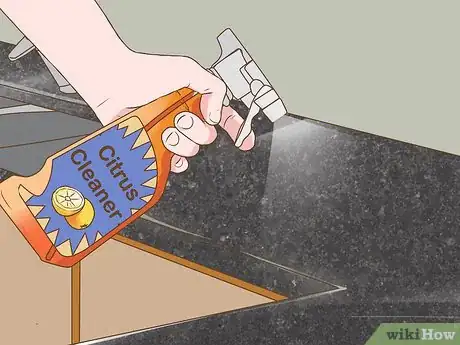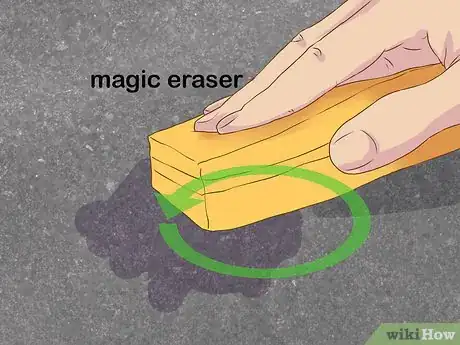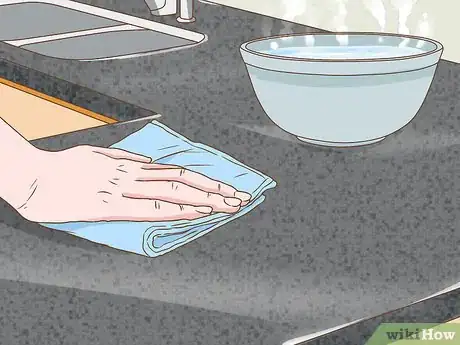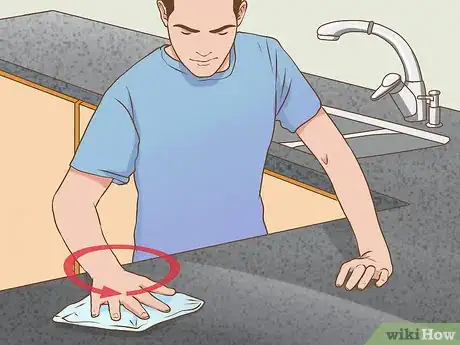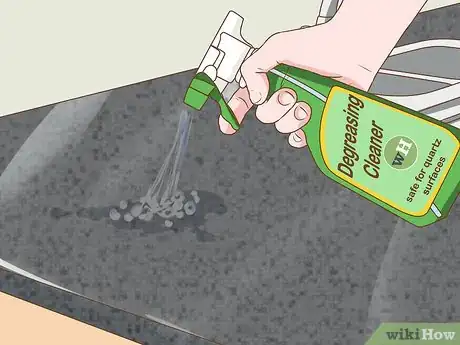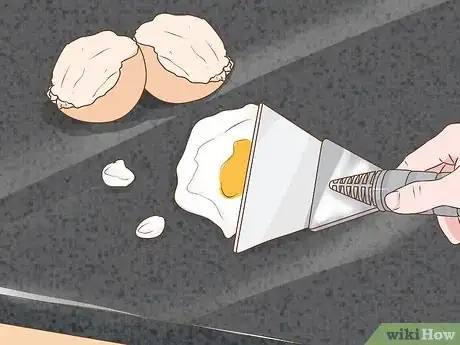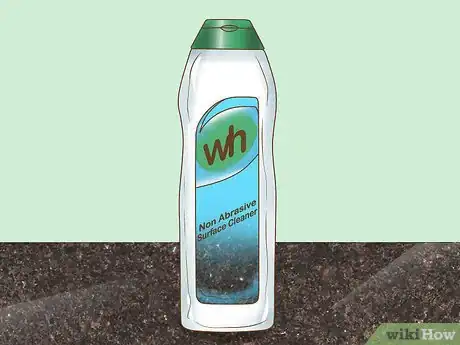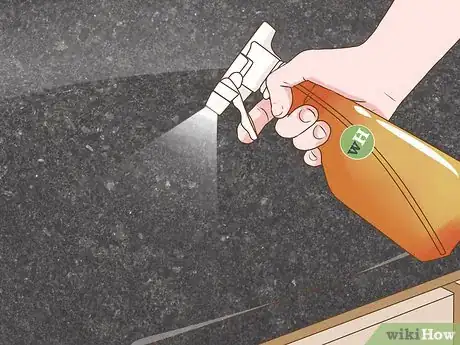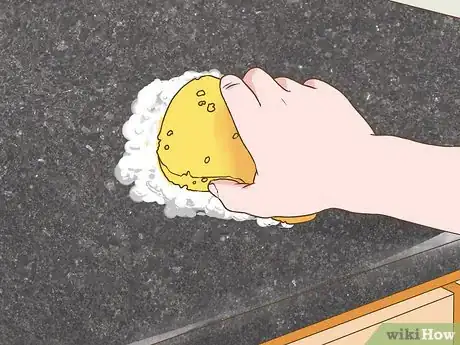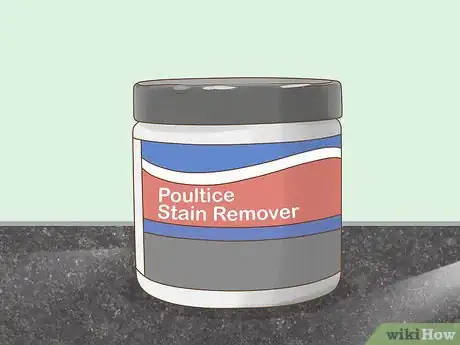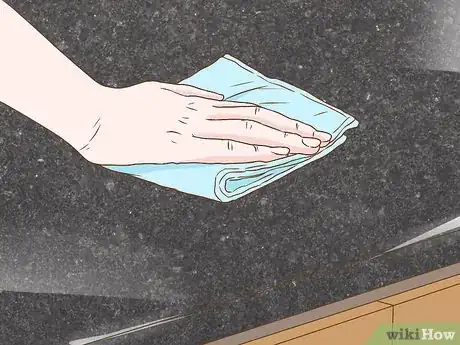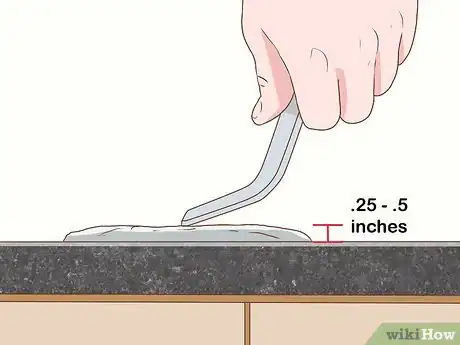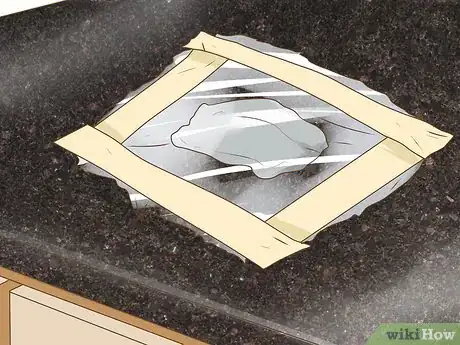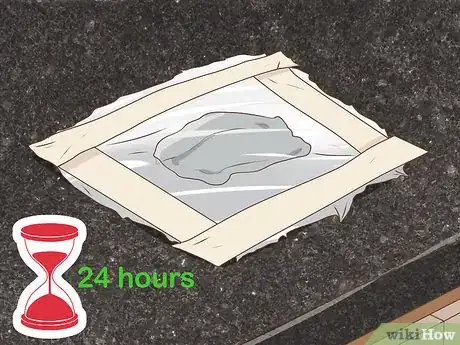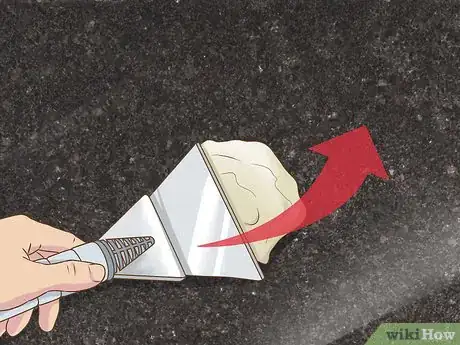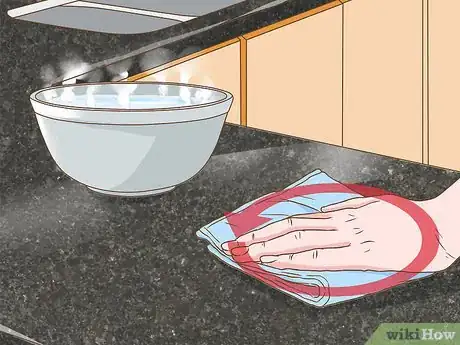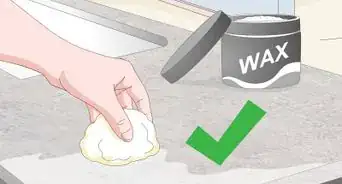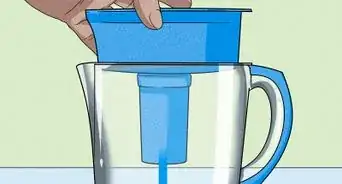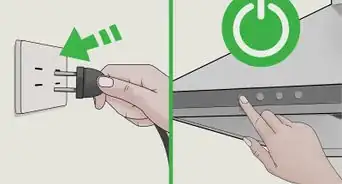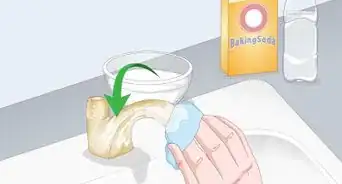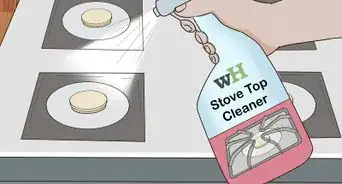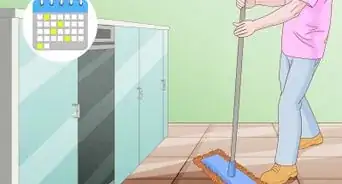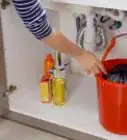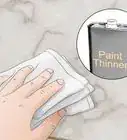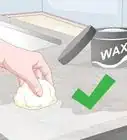This article was co-authored by Susan Stocker. Susan Stocker runs and owns Susan’s Green Cleaning, the #1 Green Cleaning Company in Seattle. She is well known in the region for outstanding customer service protocols — winning the 2017 Better Business Torch Award for Ethics & Integrity —and her energetic support of green cleaning practices.
This article has been viewed 42,420 times.
Quartz is a popular material for kitchen countertops and tables. It's scratch-resistant, antimicrobial, and easy to clean. However, it's not stain-proof or scratch-proof. Whether you have a quartz countertop or are thinking of installing one, you'll need to know how to safely perform daily cleanings, tackle stains, do twice-yearly deep cleanings, and make a poultice for especially tough stains.
Steps
Cleaning Stains
-
1Remove sticky messes with citrus-based cleaner. Spray the affected area with Goo Gone or a similar citrus cleaner. Make sure the label states that the product is safe for quartz. Rub the area with a clean nonabrasive cloth using gentle counterclockwise strokes. Dry the area with a clean nonabrasive cloth.
-
2Tackle wine with a magic eraser. Wet the magic eraser under a stream of warm water. Wring out the excess. Rub the stain in a gentle counterclockwise motion until it vanishes. This will work for spills and circular marks from glasses and goblets. Use a clean nonabrasive cloth to dry the area.[1]Advertisement
-
3Use warm water before anything else. Soak a clean nonabrasive cloth with warm water. Wipe the stain in a gentle counterclockwise motion. Use a clean soft cloth to dry the affected area.
-
4Remove permanent marker with rubbing alcohol. If warm water doesn't work, wet a cotton ball with isopropyl (rubbing) alcohol. Rub the stain in a gentle counterclockwise motion until the stain disappears. Dry the area with a clean soft cloth.[2]
Performing a Daily Cleaning
-
1Wipe down the countertop. Use a clean soft cloth to avoid scratching the surface. Mix equal parts warm water and dish washing liquid. Dip the cloth in the soapy water and wring out the excess. Wipe the surface using gentle counterclockwise strokes. Dry the surface with a clean nonabrasive cloth.[3]
- Even if you don't soil the countertop, wipe it down every day to keep it in good repair.
-
2Fight grease with degreasing cleaner. You can buy this product in grocery stores or big box stores. Stick to a product labeled safe for quartz surfaces. Spray the cleaner on a clean nonabrasive cloth. Clean the countertop in a gentle counterclockwise motion. Rinse the surface immediately.
- As an alternative, you can use disinfectant wipes that don't contain bleach.
-
3Scrape away hardened spills. This includes egg, nail polish, and similar substances. Use a blunt plastic scraper to tackle these substances. Aim for the underside of the mess, scraping away from your body.
Performing a Deep Cleaning
-
1Purchase nonabrasive surface cleaner. You can find it in big box stores or grocery stores in the same aisle as glass cleaner. Make sure it's free of alkaline chemicals like lye or acidic chemicals like vinegar. The label should point out that the product is safe for quartz.
-
2Spray the cleaner on the countertop. Apply enough cleaner to cover the surface of the countertop. Let it sit for approximately 10 minutes. This will give the product enough time to remove any deeply embedded dirt.[4]
-
3Wipe away the cleaner. Dampen a clean nonabrasive sponge or cloth. Glide it across the countertop in gentle counterclockwise strokes until the cleaner is completely removed. Dry the surface with a clean nonabrasive cloth.[5]
Using a Countertop Poultice
-
1Purchase a stone poultice. This is a fine powdered substance that you can find in most home improvement stores. It's designed to pull stains out of quartz and other stone surfaces. Make sure the product is non-acidic.[6]
-
2Mix with water. Scoop about a cup (0.95 metric cups) of powder into a clean bowl or plastic container. Gradually add water until you have a substance as thick as peanut butter. Mix as you add the water.[7]
-
3Wet the stained area. Use a clean nonabrasive cloth. Moisten it with warm water. Lay the cloth on the stain immediately before you're ready to apply the poultice.[8]
-
4Apply the poultice to the stain. Get a blunt plastic scraper. Use it to gradually scoop out the substance and lay it on the stain. Keep doing this until the poultice is about 0.25 inches (0.64 cm) to 0.5 inches (1.3 cm) high.[9]
-
5Cover the poultice. Lay plastic over the poultice. This could be cling film or an old plastic bag cut into smaller pieces. Secure the plastic with painter's tape. Let it sit for 24 hours.[10]
-
6Let the poultice air dry. After 24 hours, the poultice will be partially to half dry. Remove the plastic. Then, allow the poultice to finish drying. This will take about another 24 hours.[11]
-
7Remove the dry poultice. If the poultice hasn't dried after 48 hours, check it every hour or so until it is completely dry. When it feels hard to the touch, gently remove it with a plastic scraper. Insert the scraper under the poultice and push forward. Keep doing this until you've completely removed the poultice.[12]
-
8Rinse and dry the area. Moisten a clean nonabrasive cloth with warm water. Rub the affected area in a gentle counterclockwise motion. When the surface is completely free of poultice remnants, dry it with another clean nonabrasive cloth.[13]
Expert Q&A
-
QuestionWhat should you not use on quartz countertops?
 Susan StockerSusan Stocker runs and owns Susan’s Green Cleaning, the #1 Green Cleaning Company in Seattle. She is well known in the region for outstanding customer service protocols — winning the 2017 Better Business Torch Award for Ethics & Integrity —and her energetic support of green cleaning practices.
Susan StockerSusan Stocker runs and owns Susan’s Green Cleaning, the #1 Green Cleaning Company in Seattle. She is well known in the region for outstanding customer service protocols — winning the 2017 Better Business Torch Award for Ethics & Integrity —and her energetic support of green cleaning practices.
Green Cleaning Expert Cleaners that contain vinegar or lemon can damage the finish or sealant on quartz countertops. Gentle cleaners are best.
Cleaners that contain vinegar or lemon can damage the finish or sealant on quartz countertops. Gentle cleaners are best.
Warnings
- Make sure all cleaners, especially citrus-based cleaners, are formulated as safe for quartz surfaces.⧼thumbs_response⧽
- Avoid using cleaning with abrasive substances or cleaners that are too acidic/alkaline. Anything used to clean quartz must have a pH of around 7.[14]⧼thumbs_response⧽
- When scraping dried gunk, avoid using anything metal. Although quartz is scratch-resistant, it's not scratch-proof. Even a dull butter knife can cause permanent damage.[15]⧼thumbs_response⧽
Things You'll Need
- Clean cloths
- Dish washing liquid
- Degreaser or bleach-free disinfectant wipes
- Blunt plastic scraper
- Citrus-based cleaners
- Cotton ball
- Rubbing alcohol
- Magic eraser
- Nonabrasive surface cleaner
- Stone poultice
- Plastic
- Painter's tape
References
- ↑ https://www.youtube.com/watch?v=pbrtIzc5Q_0
- ↑ https://www.realsimple.com/new-uses-for-old-things/new-uses-cleaning/rubbing-alcohol-as-permanent-marker-remover
- ↑ https://www.bobvila.com/articles/how-to-clean-quartz-countertops/
- ↑ https://www.bobvila.com/articles/how-to-clean-quartz-countertops/#.WRjh1rkzrVo
- ↑ https://www.bobvila.com/articles/how-to-clean-quartz-countertops/#.WRjh1rkzrVo
- ↑ http://www.daltile.com/inspiration-and-diy/countertops/how-to-clean-and-seal-granite-countertops
- ↑ http://www.daltile.com/inspiration-and-diy/countertops/how-to-clean-and-seal-granite-countertops
- ↑ http://www.daltile.com/inspiration-and-diy/countertops/how-to-clean-and-seal-granite-countertops
- ↑ http://www.daltile.com/inspiration-and-diy/countertops/how-to-clean-and-seal-granite-countertops
- ↑ http://www.daltile.com/inspiration-and-diy/countertops/how-to-clean-and-seal-granite-countertops
- ↑ http://www.daltile.com/inspiration-and-diy/countertops/how-to-clean-and-seal-granite-countertops
- ↑ http://www.daltile.com/inspiration-and-diy/countertops/how-to-clean-and-seal-granite-countertops
- ↑ http://www.daltile.com/inspiration-and-diy/countertops/how-to-clean-and-seal-granite-countertops
- ↑ http://www.daltile.com/inspiration-and-diy/countertops/how-to-clean-and-seal-granite-countertops
- ↑ https://www.bobvila.com/articles/how-to-clean-quartz-countertops/#.WRjh1rkzrVo
About This Article
To clean quartz countertops without scratching them, dust any crumbs or dirt off of the counter with a soft, clean cloth. Then, dip the cloth in soapy water and wipe down the counter again, working with gentle circular strokes. If the countertop has been soiled with a greasy substance, spray the surface with a degreaser that’s labeled safe for use on quartz surfaces. After you clean the counter, wipe it clean with a soft, dry cloth. Keep reading to learn how to tackle tough stains, like permanent marker!
